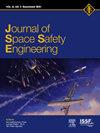Design and development of a space suit mock-up for VR-based EVA research and simulation
IF 1.7
Q3 ENGINEERING, AEROSPACE
引用次数: 0
Abstract
Earth-based Extra-Vehicular Activity (EVA) simulation has always been the subject of study by space agencies aimed at reproducing the most accurate experience for astronauts. Challenges and limitations are many and not limited to the natural Laws; the space suit system, an integral part of the successful Extra-Vehicular Activity (EVA), must present the same conditions to the user as it would in the environment of operation. NASA is the most prominent example of a long tradition for a faithful simulation of outer space in which astronauts operate during EVAs: the Neutral Buoyancy Lab at Johnson Space Center in Houston still represents the standard when it comes to providing astronauts with a realistic experience. However, such infrastructures can be difficult to access, considering the renewed interest in space, which is advocated by new private players looking into Low Earth Orbit (LEO) access in the short to medium term. Virtual Reality (VR) provides users with new, flexible, and relatively inexpensive ways of simulating the space environment during an EVA, without the need to build large-scale pools and mock-ups of vehicles. In this paper, it'll be shown how the Sasakawa International Center for Space Architecture (SICSA) at the University of Houston is working to provide students and researchers with a Virtual Reality (VR)-based infrastructure to simulate EVAs and Space Architectures, which are also designed in-situ. An essential component to achieve realism of experience is the design and construction, done entirely in-house, of a mock-up of the latest NASA Artemis Exploration Extra Vehicular Mobility Unit (xEMU) space suit, to recreate the physical constraints that such a garment imposes on astronauts, which cannot be entirely simulated with VR. It'll be shown how this space suit replica substantially enhances the accuracy of the experience, by replicating the mechanisms of the xEMU suit, complementing the virtual experience provided at the same time.
设计和开发太空服模型,用于基于 VR 的 EVA 研究和模拟
基于地球的舱外活动(EVA)模拟一直是航天机构研究的主题,旨在为宇航员再现最准确的体验。挑战和限制是很多的,并不局限于自然法则;太空服系统是成功的舱外活动(EVA)的一个组成部分,它必须向用户提供与在操作环境中相同的条件。美国国家航空航天局(NASA)是长期以来忠实模拟宇航员在舱外活动期间操作的外太空的最突出的例子:休斯顿约翰逊航天中心的中性浮力实验室(Neutral Buoyancy Lab)仍然代表着为宇航员提供真实体验的标准。然而,考虑到在中短期内寻求近地轨道(LEO)访问的新私人参与者所倡导的对空间的重新兴趣,这种基础设施可能很难进入。虚拟现实(VR)为用户提供了新的、灵活的、相对便宜的方法来模拟EVA期间的空间环境,而不需要建立大规模的水池和飞行器模型。在本文中,它将展示休斯顿大学Sasakawa国际空间建筑中心(SICSA)如何为学生和研究人员提供基于虚拟现实(VR)的基础设施来模拟eva和空间架构,这些基础设施也是在现场设计的。实现现实体验的一个重要组成部分是设计和建造一个完全由内部完成的美国宇航局最新的阿尔忒弥斯探索舱外移动单元(xEMU)宇航服的模型,以重现这种服装对宇航员施加的物理限制,这些限制不能完全用VR模拟。它将展示这个太空服复制品如何通过复制xEMU宇航服的机制来大大提高体验的准确性,同时补充提供的虚拟体验。
本文章由计算机程序翻译,如有差异,请以英文原文为准。
求助全文
约1分钟内获得全文
求助全文
来源期刊

Journal of Space Safety Engineering
Engineering-Safety, Risk, Reliability and Quality
CiteScore
2.50
自引率
0.00%
发文量
80
 求助内容:
求助内容: 应助结果提醒方式:
应助结果提醒方式:


